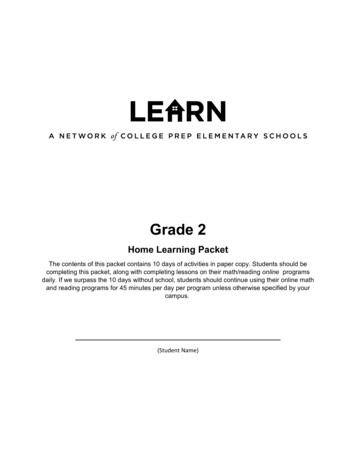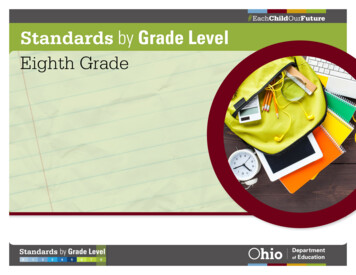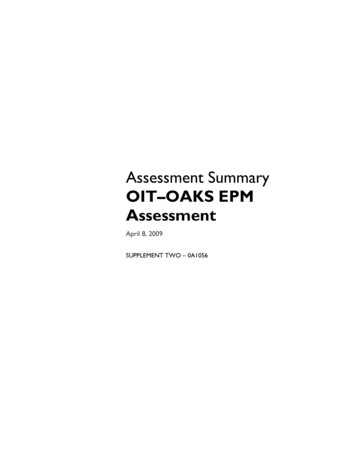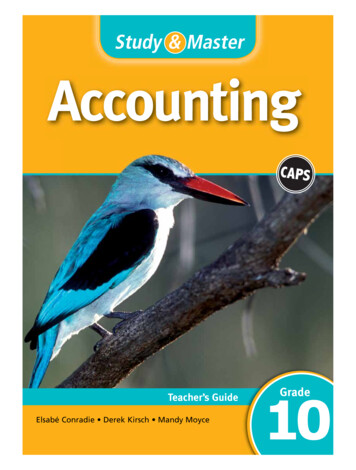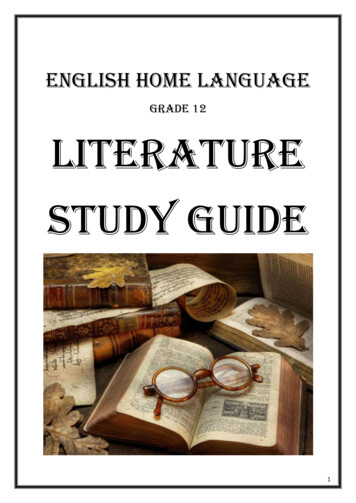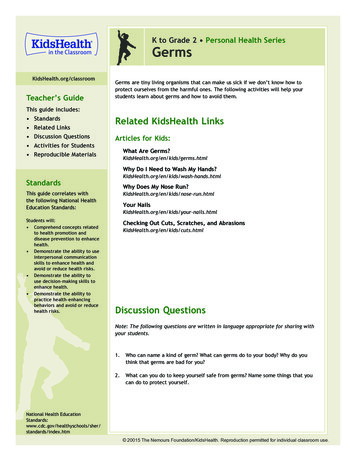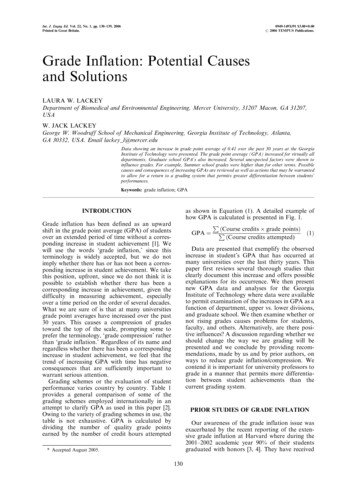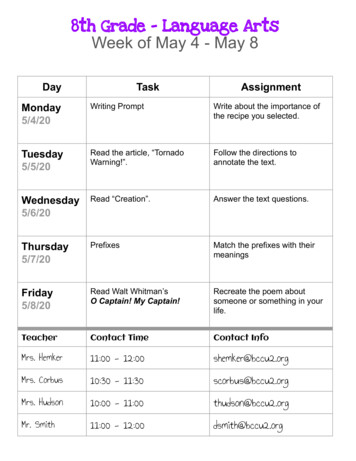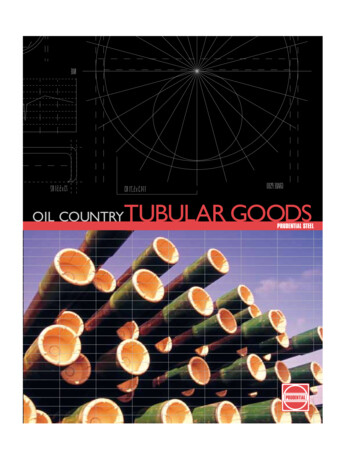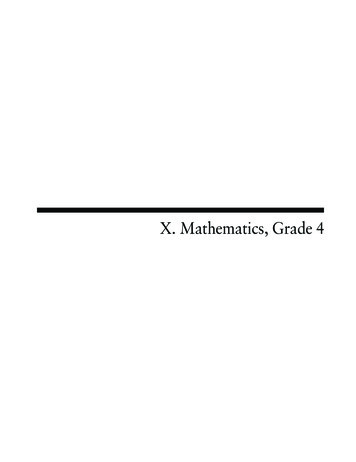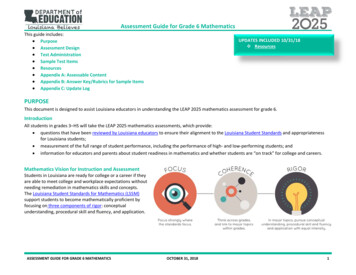
Transcription
Assessment Guide for Grade 6 MathematicsThis guide includes: Purpose Assessment Design Test Administration Sample Test Items Resources Appendix A: Assessable Content Appendix B: Answer Key/Rubrics for Sample Items Appendix C: Update LogUPDATES INCLUDED 10/31/18 ResourcesPURPOSEThis document is designed to assist Louisiana educators in understanding the LEAP 2025 mathematics assessment for grade 6.IntroductionAll students in grades 3–HS will take the LEAP 2025 mathematics assessments, which provide: questions that have been reviewed by Louisiana educators to ensure their alignment to the Louisiana Student Standards and appropriatenessfor Louisiana students; measurement of the full range of student performance, including the performance of high- and low-performing students; and information for educators and parents about student readiness in mathematics and whether students are “on track” for college and careers.Mathematics Vision for Instruction and AssessmentStudents in Louisiana are ready for college or a career if theyare able to meet college and workplace expectations withoutneeding remediation in mathematics skills and concepts.The Louisiana Student Standards for Mathematics (LSSM)support students to become mathematically proficient byfocusing on three components of rigor: conceptualunderstanding, procedural skill and fluency, and application.ASSESSMENT GUIDE FOR GRADE 6 MATHEMATICSOCTOBER 31, 20181
Assessment Guide for Grade 6 Mathematics Conceptual understanding refers to understanding mathematical concepts, operations, and relations. It is more than knowing isolated facts andmethods. Students should be able to make sense of why a mathematical idea is important and the kinds of contexts in which it is useful. It alsoallows students to connect prior knowledge to new ideas and concepts.Procedural Skill and Fluency is the ability to apply procedures accurately, efficiently, and flexibly. It requires speed and accuracy in calculationwhile giving students opportunities to practice basic skills. Students’ ability to solve more complex application tasks is dependent on proceduralskill and fluency.Application provides a valuable context for learning and the opportunity to solve problems in a relevant and a meaningful way. It is through realworld application that students learn to select an efficient method to find a solution, determine whether the solution(s) makes sense byreasoning, and develop critical thinking skills.ASSESSMENT DESIGNSupporting Key Goals in Mathematics InstructionThe LEAP 2025 Mathematics Assessments focus on testing the LSSM according to the components of rigor reflected in high-quality mathematicsinstructional tasks that: require students to demonstrate understanding of mathematical reasoning in mathematical and applied contexts; assess accurate, efficient, and flexible application of procedures and algorithms; rely on application of procedural skill and fluency to solve complex problems; and require students to demonstrate mathematical reasoning and modeling in real-world contexts.Assessable ContentEach item on the LEAP 2025 mathematics assessment is referred to as a task and is identified by one of three types: Type I, Type II, or Type III. The taskson the LEAP 2025 mathematics test are aligned directly to the Louisiana Student Standards for Mathematics (LSSM) for all reporting categories. Type I tasks, designed to assess conceptual understanding, fluency, and application, are aligned to the major, additional, and supporting contentfor grade 6. Type II tasks are designed to assess student reasoning ability of selected major content for grades 5 or 6 in applied contexts. Type III tasks are designed to assess student modeling ability of selected content for grades 5 or 6 in applied contexts. Type II and III tasks arefurther aligned to LEAP 2025 evidence statements for the Expressing Mathematical Reasoning and Modeling & Application reporting categories.All tasks are reviewed and vetted by teacher committees to verify direct and full alignment to the LSSM. LEAP 2025 evidence statements for grade 6 arelabeled as “LEAP.II.6.#” for Type II tasks and “LEAP.III.6.#” for Type III tasks. See the table in Appendix A for a listing of assessable content of the LSSMand LEAP 2025 evidence statements.Each of the three task types is aligned to one of four reporting categories: Major Content, Additional & Supporting Content, Expressing MathematicalReasoning, or Modeling & Application. Each task type is designed to align with at least one of the Louisiana Student Standards for Mathematical Practice(MP), found on pages 6-8 in the K-12 Louisiana Student Standards for Mathematics.ASSESSMENT GUIDE FOR GRADE 6 MATHEMATICSOCTOBER 31, 20182
Assessment Guide for Grade 6 MathematicsTaskTypeDescriptionMathematical Practice(MP)Reporting CategoryTypeIconceptual understanding,fluency, and applicationTypeIIwritten arguments/justifications,critique of reasoning, or precisionin mathematical statementsTypeIIImodeling/application in a realworld context or scenarioMajor Content: solve problems involving the major content for grade 6Additional & Supporting Content: solve problems involving theadditional and supporting content for grade 6Expressing Mathematical Reasoning: express mathematical reasoningby constructing mathematical arguments and critiquesModeling & Application: solve real-world problems engagingparticularly in the modeling practicecan involve any or allpracticesprimarily MP.3 and MP.6,but may also involve anyof the other practicesprimarily MP.4, but mayalso involve any of theother practicesThe Major Content reporting category is divided, based on Achievement Level Descriptors, into the following subcategories.SubcategoryAssociated LSSM and LEAP 2025Evidence StatementsRationalNumbers/Multiply andDivide Fractions6.NS.A.1, 6.NS.C.5, 6.NS.C.6, 6.NS.C.7,6.NS.C.8Ratio and RateExpressions, Equations,and InequalitiesDescription6.RP.A.1, 6.RP.A.2, 6.RP.A.36.EE.A.1, 6.EE.A.2, 6.EE.A.4, 6.EE.B.5,6.EE.B.6, 6.EE.B.7, 6.EE.B.8, 6.EE.C.9Students solve mathematical and word problems using multiplicationand division with fractions. Students understand and apply positive andnegative numbers to real-world contexts and represent them on thenumber line.Students apply ratio and rate reasoning to solve mathematical and wordproblems, including percent and unit conversions.Students apply properties of operations to evaluate numerical andalgebraic expressions and identify equivalent expressions. Studentswrite, solve, and graph solutions of single-step equations andinequalities posed from mathematical and real-world problems.These reporting categories will provide parents and educators valuable information about overall student performance, including readiness to continue further studies in mathematics; student performance broken down by mathematics content and practices, which may help identify when students need additional support ormore challenging work; student performance in Major Content broken down by content subcategories, which may help teachers and schools home in on specificcontent for professional development; and how well schools and districts are helping students achieve higher expectations.ASSESSMENT GUIDE FOR GRADE 6 MATHEMATICSOCTOBER 31, 20183
Assessment Guide for Grade 6 MathematicsAchievement-Level DefinitionsAchievement-level definitions briefly describe the expectations for student performance at each of Louisiana’s five achievement levels, described below: Advanced: Students performing at this level have exceeded college and career readiness expectations, and are well prepared for the next levelof studies in this content area. Mastery: Students performing at this level have met college and career readiness expectations, and are prepared for the next level of studies inthis content area. Basic: Students performing at this level have nearly met college and career readiness expectations, and may need additional support to be fullyprepared for the next level of studies in this content area. Approaching Basic: Students performing at this level have partially met college and career readiness expectations, and will need much supportto be prepared for the next level of studies in this content area. Unsatisfactory: Students performing at this level have not yet met the college and career readiness expectations, and will need extensivesupport to be prepared for the next level of studies in this content area.Test DesignThe LEAP 2025 mathematics assessment in grade 6 contains a total of 43 tasks for 66 points. The table below shows the breakdown of the number oftasks and point values by Reporting Category and Session.Reporting CategoryMajor ContentAdditional & Supporting ContentExpressing Mathematical ReasoningModeling & ApplicationTOTAL OperationalTotal Embedded Field-TestSession TimeSession 1:No CalculatorTasks Points10-12126-88000016-20202-3N/A60 minutesSession 2:CalculatorTasks Points6-881-22272912-13262-3N/A90 minutesSession 3CalculatorTasks Points8-101000271311-13201N/A90 minutesTOTALTasks Points26-30306-101041431243665-7N/A240 minutesNote: The test will contain additional field-test tasks. The field-test tasks do not count towards a student’s final score on the test; they provideinformation that will be used to help develop future test forms.ASSESSMENT GUIDE FOR GRADE 6 MATHEMATICSOCTOBER 31, 20184
Assessment Guide for Grade 6 MathematicsThe following table includes information on the total tasks, total points, and percentage of assessment points by task-type point-values.Task TypesType IType IIType IIIPoint-Values Total Tasks1-point tasks322-point tasks43-point tasks24-point tasks23-point tasks26-point tasks1TOTAL43Total Points324086148612666Percentage of Assessment Points49%61%12%9%21%12%9%18%9%100%TEST ADMINISTRATIONAdministration ScheduleThe computer-based testing window opens April 1, 2019 and runs through May 3, 2019. The school or district test coordinator will communicate thetesting schedule.All LEAP 2025 assessments are timed. No additional time is permitted, except for students who have a documented accommodation (e.g., an IEP).Scheduling Requirements for Computer-Based TestingComputer-based testing allows districts some flexibility in scheduling. However, to reduce incidences of testing irregularities, districts must adhere tothe following scheduling and administration practices: Testing students in the same grade level across the school at or very close to the same time Completing makeup testing for students immediately upon their return Limiting student interaction during breaks between test sessions Isolating students who have not completed testing for the day (e.g., students with extended time accommodation) Preventing interaction between groups of students taking the same tests at different times within a testing day Requiring the completion of a session once it is opened (i.e., limiting the reopening of test sessions) Taking the sessions within a content area in the correct order (e.g., ELA Session 1 taken before ELA Session 2)We also recommend: limiting sessions to no more than three in one day for a student; and administering no more than one session that includes an extended-response task or writing prompt (i.e., ELA Session 1, and ELA Session 2) in aday to an individual student.For more information about scheduling and administration policies, refer to the CBT Guidance document, found in the LDOE Assessment library.ASSESSMENT GUIDE FOR GRADE 6 MATHEMATICSOCTOBER 31, 20185
Assessment Guide for Grade 6 MathematicsOnline ToolsThe tests include the following online tools, which allow a student to select answer choices, “mark” tasks, eliminate answer options, use a calculator,take notes, enlarge the task, guide the reading of a task line by line, see the mathematics reference sheet, use a ruler and protractor, and use anequation builder for entering special characters. A help tool is also featured to assist students as they use the online system. Pointer tool Sticky Note tool Measurementtools Highlighter tool Magnifying tool Equation Builder Cross-Off tool Line Guide Help tool Calculator MathematicsReference SheetAll students taking the computer-based tests should work through the Online Tools Training to practice using the online tools so they are wellprepared to navigate the online testing system.To ensure accurate measurement, thesize of the computer-based ruler andprotractor, along with the object beingmeasured, varies depending on thecomputer monitor’s resolution. Topractice with the computer-based rulerand protractor, visit the Online ToolsTraining (available in INSIGHT or hereusing the Chrome browser).ASSESSMENT GUIDE FOR GRADE 6 MATHEMATICSGrade 6 rulers and protractor provided on the LEAP 2025 CBT (not actual size):OCTOBER 31, 20186
Assessment Guide for Grade 6 MathematicsPermitted Testing MaterialsThe chart that follows summarizes the tools and resources for the grade 6 mathematics assessment.ToolsProvidedSession 1Sessions 2 & 3scratch paper (lined, graph, un-lined), two pencilsby Test AdministratorYESYES 𝟏𝟏onlineYESYES NOYESYESYES𝟖𝟖 inch ruler, centimeter ruler, and protractorcalculatorGrade 6 Mathematics Reference Sheetonline and/orby Test Administratoronline and/orby Test Administrator GuidelinesReference sheets may beprinted from eDIRECTTools provided by TestAdministrator must notbe written onSee Calculator Policy forcalculator specificationsCalculator PolicyThe LEAP 2025 mathematics test allows afour-function calculator in grade 6 duringSessions 2 and 3. Calculators are not allowedduring Session 1 of the test. For studentswith the approved accommodation, ahandheld four-function calculator is allowedduring all test sessions.Calculator PolicySession 1Sessions 2 & 3General TestersNot allowedFour-function calculatoravailable online,Testers with approvedFour-function calculator available online,may also have handheldaccommodation for calculatormay also have handheldAdditional information for testers with approved accommodations for calculator use: If a student needs an adaptive calculator (e.g., large key, talking), the student may bring his or herown or the school may provide one, as long as it is specified in his or her approved IEP or 504 Plan.Additionally, schools must adhere to the following guidance regarding calculators. Four-function calculators may have square root, percent, memory, and /- keys. Calculators with the following features are not permitted:o Computer Algebra System (CAS) featureso “QWERTY” keyboardso paper tapeo talk or make noise, unless specified in IEP/IAPo tablet, laptop (or PDA), phone-based, or wristwatch Students are not allowed to share calculators within a testing session. Test administrators must confirm that memory on all calculators has been cleared before andafter the testing sessions. The student should use the calculator they have used regularly throughout the school year intheir classroom and are most familiar with, provided their regular-use calculator is not outside the boundaries of what is allowed. If schools or districts permit students to bring their own handheld calculators, test administrators must confirm that the calculators meet all therequirements as defined above.ASSESSMENT GUIDE FOR GRADE 6 MATHEMATICSOCTOBER 31, 20187
Assessment Guide for Grade 6 MathematicsReference Sheet 1 inch 2.54 cm1 m 39.37 inches1 mile 5280 feet1 mile 1760 yards1 mile 1.609 km 1 km 0.62 mile1 pound 16 ounces1 pound 0.454 kg1 kg 2.2 pounds1 ton 2000 poundsTriangleRight Rectangular PrismRequisite Knowledge 1 m 100 cm 1 foot 12 inches1 m 1000 mm 1 yard 3 feet1 km 1000 m 1 day 24 hours1 kg 1000 g 1 minute 60 seconds1 g 1000 mg 1 hour 60 minutes1 L 1000 mLArea and Perimeter formulas for rectangles 1 cup 8 fluid ounces1 pint 2 cups1 quart 2 pints1 gallon 4 quarts1 gallon 3.785 L1 L 0.264 gallon1 L 1000 cubic cm1𝐴𝐴 𝑏𝑏ℎ2𝑉𝑉 𝐵𝐵ℎ or 𝑉𝑉 𝑙𝑙𝑙𝑙ℎStudents in grade 6 will be provided a reference sheetwith the information below. The Grade 6 MathematicsReference Sheet may be printed from eDirect or foundin the Assessment Guidance library on page 2 of LEAP2025 Grades 5-HS Mathematics Reference Sheets.Students in grade 6 will be required to know relative sizes of measurement units within onesystem of units. Therefore, the listed requisite knowledge is necessary for the grade 6assessments and is not provided in the reference sheet.Item TypesAll of the item types in the following list will appear on the test. Multiple Choice (MC) – This item type asks students to choose one correct answer from four and may appear as a one-part question, as part of atwo-part question, or as a part of a CR item. The MC items are worth one point. Multiple Select (MS) – This item type asks students to choose more than one correct answer and may appear as a one-part question, as part ofa two-part question, or as a part of a CR item. Whenever this item type is used, the question always identifies in boldface print that more thanone answer is required. The question may or may not specify the exact number of correct answers. The MS items are worth one point. Studentsmust choose all correct answers and no incorrect answer can be chosen. Short Answer (SA) – This item type asks students to key numeric answers into an entry box using the keyboard and may appear as a one-partquestion, as part of a two-part question, or as a part of a CR item. The SA items are worth one point. Unless specified in the question, a studentwill earn credit for an answer that is mathematically equivalent to the correct numerical answer. Answers to SA items can be positive ornegative and must be entered in integer or decimal form.ASSESSMENT GUIDE FOR GRADE 6 MATHEMATICSOCTOBER 31, 20188
Assessment Guide for Grade 6 Mathematics Keypad Input (KI) – This item type asks students to key numeric or algebraic answers in the form of fractions, mixed numbers, expressions,equations, or inequalities. This item type may appear as a one-part question, as part of a two-part question, or as a part of a constructedresponse item. The KI items are worth one point. Unless specified in the question, a student will earn credit for an answer that is equivalent tothe correct numeric or algebraic response. Technology Enhanced (TE) – This item type uses technology to capture student responses and may appear as a one-part question, as part of atwo-part question, or as a part of a CR item. The TE items are worth one point. Students must meet the requirements of the question exactly toreceive credit. The Online Tools Training (OTT) allows students to practice answering the different types of TE questions. For a summary of thedifferent kinds of TE items and where to find examples, refer to LEAP 2025 Technology-Enhanced Item Types. Constructed Response (CR) – This item type can be single- or multi-part. CR items ask students to create a written explanation or justification,model a process, and/or compute an answer to earn a series of points. A student may receive partial or full credit on CR items, but maximumpoint values will vary by task. Maximum values for CR items are 3, 4, or 6 points. When responding to a CR item, students will type theirresponses into a response box, like the shown one below.Response BoxThe response box allows students to use the keyboard to type in their response or work. There is a limit to the number of characters that can be typed inthe response box; however, it is set will beyond what a student might produce based on grade-specific expectations of the item. The toolbar at the topof the response box has the Equation Builder tool that allows the students to create a response with commonly-used grade-specific math symbols.Equation BuilderStudents are not required to use the equation builder for any symbols which are available on the keyboard. For example, students may use a slash,forward / or back \, to represent a fraction, a carat to represent exponents, or a pair of pipes to represent absolute value. Additionally, symbols likedegree and perpendicular are not available on the keyboard, but students may type the words “degrees” and “perpendicular” as necessary. Othersymbols, such as square root and pi π, are not available on the keyboard, but may be required in symbol form for expressions and equations.The Equation Builder does not include all symbols/characters students might need to type into the response box. Students should know how to type anegative sign - and a colon : using the keyboard. The button in the Equation Builder is a multiplication symbol and should not be used as a variable x,but students are not penalized if they do.ASSESSMENT GUIDE FOR GRADE 6 MATHEMATICSOCTOBER 31, 20189
Assessment Guide for Grade 6 MathematicsUsing the Equation Builder To enter text, click pointer in the Response Box andtype text using the keyboard. Click on the Equation Builder button to open the tooland enter any math symbols, characters, or mathformat. When finished, click on the OK button in the lowerright corner of the Equation Builder tool – theequation will be entered into the response box. To cancel what you have entered, click on the Cancelbutton in the lower-right corner of the EquationBuilder tool and you will be returned to the response box. To edit an existing equation, double-click on the equation in the Response Box. This will re-open the Equation Builder.Additional Considerations for Students When Using the Equation BuilderThe symbols outlined in red below are not used in middle school math and should be ignored when using the Equation Builder tool in grades 6, 7, and 8.ASSESSMENT GUIDE FOR GRADE 6 MATHEMATICSOCTOBER 31, 201810
Assessment Guide for Grade 6 MathematicsSAMPLE TEST ITEMSThis section includes six Type I tasks, one Type II task, and one Type III task as they would appear on a test. The answer keys for each Type I task andscoring rubrics for each constructed-response task are located in Appendix B. Look for some of these tasks in the OTT.Multiple-Choice TaskASSESSMENT GUIDE FOR GRADE 6 MATHEMATICSMultiple-Select TaskOCTOBER 31, 201811
Assessment Guide for Grade 6 MathematicsTE: Drag-and-Drop / Short Answer Type I TaskASSESSMENT GUIDE FOR GRADE 6 MATHEMATICSOCTOBER 31, 201812
Assessment Guide for Grade 6 MathematicsTE: Dropdown Menu TaskASSESSMENT GUIDE FOR GRADE 6 MATHEMATICSOCTOBER 31, 201813
Assessment Guide for Grade 6 MathematicsTE: Coordinate Grid TaskASSESSMENT GUIDE FOR GRADE 6 MATHEMATICSKeypad Input TaskOCTOBER 31, 201814
Assessment Guide for Grade 6 MathematicsType II Constructed-Response TaskASSESSMENT GUIDE FOR GRADE 6 MATHEMATICSOCTOBER 31, 201815
Assessment Guide for Grade 6 MathematicsType III Constructed-Response TaskASSESSMENT GUIDE FOR GRADE 6 MATHEMATICSOCTOBER 31, 201816
Assessment Guide for Grade 6 MathematicsRESOURCESAssessment Guidance Library LEAP 2025 Equation Builder for Grades 6-8: provides teachers withinformation on using the equation builder; Spanish LEAP 2025 Grades 5-HS Mathematics Reference Sheets: includes allthe mathematics references sheets provided for LEAP 2025 testing Assessment Development Educator Review Committees: describesthe item development process and associated committees, includesinformation on applying for participationPractice Test Library LEAP 2025 Grade 6 CBT Practice Test Answer Key: includes answerkeys, scoring rubrics, and alignment information; Spanish LEAP 2025 Math Practice Test Guidance: provides guidance on usingthe math practice tests to support instructional goals Practice Test Quick Start Guide: provides information regardingadministration and scoring of the online practice testsINSIGHT Online Tools Training: allows students to become familiar with thetools available in the online testing platform; also available hereusing the Chrome browser LEAP 2025 Grade 6 Practice Test: helps prepare students for thetestsGrades 6-8 Math Teacher Library Assessment Library LEAP 2025 Accessibility and Accommodations Manual: providesinformation about accessibility features and accommodations LEAP 2025 Technology Enhanced Item Types: provides a summaryof technology enhanced items Achievement Level Descriptors: descriptions of the knowledge,skills, and cognitive processes that students should demonstratewith relative consistency and accuracy at each level of achievement LEAP 360: non-summative assessment system; includes diagnosticand interim assessmentseDIRECT includes access to tutorials, manuals, and user guidesASSESSMENT GUIDE FOR GRADE 6 MATHEMATICSEAGLE : part of the LEAP 360 system which allows teachers tointegrate high-quality questions into daily lessons through teachercreated tests, premade assessments, and items for small groupinstruction K-12 Louisiana Student Standards for Math: explains thedevelopment of and lists the math content standardsGrade 6 Math - Teachers Companion Document 2.0: containsdescriptions of each standard to answer questions about thestandard’s meaning and how it applies to student knowledge andperformanceGrade 6 Remediation Guide: identifies the specific remedialstandards necessary for every standard, includes information oncontent emphasisK-12 LSSM Alignment to Rigor: provides explanations and astandards-based alignment to assist teachers in incorporating thethree components of rigor into instructionContact Us AskLDOE electronic ticket systemassessment@la.gov for assessment questionsclassroomsupporttoolbox@la.gov for curriculum and instructionquestionsNewsroom: offers archive copies of newsletters including the LDOEWeekly School System Newsletter and the Teacher Leader NewsletterOCTOBER 31, 201817
Assessment Guide for Grade 6 MathematicsAPPENDIX AAssessable Content for the Major Content Reporting Category (Type I)LSSM Content Standards6.RP.AUnderstand ratio concepts and use ratio reasoning to solve problems.6.RP.A.1Understand the concept of a ratio and use ratio language to describe a ratio relationship between two quantities. For example, "The ratioof wings to beaks in the bird house at the zoo was 2:1, because for every 2 wings there was 1 beak." "For every vote candidate A received,candidate C received nearly three votes."6.RP.A.2Understand the concept of a unit rate a/b associated with a ratio a:b with b 0, and use rate language in the context of a ratiorelationship. For example, "This recipe has a ratio of 3 cups of flour to 4 cups of sugar, so there is 3/4 cup of flour for each cup of sugar.""We paid 75 for 15 hamburgers, which is a rate of 5 per hamburger." 16.RP.A.3Use ratio and rate reasoning to solve real-world and mathematical problems, e.g., by reasoning about tables of equivalent ratios, tapediagrams, double number line diagrams, or equations.a. Make tables of equivalent ratios relating quantities with whole-number measurements, find missing values in the tables, and plot thepairs of values on the coordinate plane. Use tables to compare ratios.b. Solve unit rate problems including those involving unit pricing and constant speed. For example, if it took 7 hours to mow 4 lawns,then at that rate, how many lawns could be mowed in 35 hours? At what unit rate were lawns being mowed?c. Find a percent of a quantity as a rate per 100 (e.g., 30% of a quantity means 30/100 times the quantity); solve problems involvingfinding the whole, given a part and the percent.d. Use ratio reasoning to convert measurement units; manipulate and transform units appropriately when multiplying or dividingquantities.6.NS.AApply and extend previous understandings of multiplication and division to divide fractions by fractions.6.NS.A.1 Interpret and compute quotients of fractions, and solve word problems involving division of fractions by fractions, e.g., by using visualfraction models and equations to represent the problem. For example, create a story context for (2/3) (3/4) and use a visual fractionmodel to show the quotient; use the relationship between multiplication and division to explain that (2/3) (3/4) 8/9 because 3/4 of 8/9is 2/3. (In general, (a/b) (c/d) ad/bc.) How much chocolate will each person get if 3 people share 1/2 lb of chocolate equally? Howmany 3/4-cup servings are in 2/3 of a cup of yogurt? How wide is a rectangular strip of land with length 3/4 mi and area 1/2 square mi?.6.NS.CApply and extend previous understandings of numbers to the system of rational numbers.6.NS.C.5Understand that positive and negative numbers are used together to describe quantities having opposite directions or values (e.g.,temperature above/below zero, elevation above/below sea level, credits/debits, positive/negative electric charge); use positive andnegative numbers to represent quantities in real-world contexts, explaining the meaning of 0 in each situation.1Expectations for unit rates in this grade are limited to non-complex fractions.ASSESSMENT GUIDE FOR GRADE 6 MATHEMATICSOCTOBER 31, 201818
Assessment Guide for Grade 6 .EE.A.2Understand a rational number as a point on the number line. Extend number line diagrams and coordinate axes familiar from previousgrades to represent points on the line and in the plane with negative number coordinates.a. Recognize opposite signs of numbers as indicating locations on opposite sides of 0 on the number line; recognize that the opposite ofthe opposite of a number is the number itself, e.g., -(-3) 3, and that 0 is its own opposite.b. Understand signs of numbers in ordered pairs as indicating locations in quadrants of the coordinate plane; recognize that when twoordered pairs differ only by signs, the locations of the points are related by reflections across one or both axes.c. Find and position integers and other rational numbers on a horizontal or vertical number line diagram; find and position pairs ofintegers and other rational numbe
ASSESSMENT GUIDE FOR GRADE 6 MATHEMATICS OCTOBER 31, 2018 1 . information for educators and parents about stu dent readiness in math ematics and whether students are “on track” for college and careers . . 60 minutes 90 minutes 90
